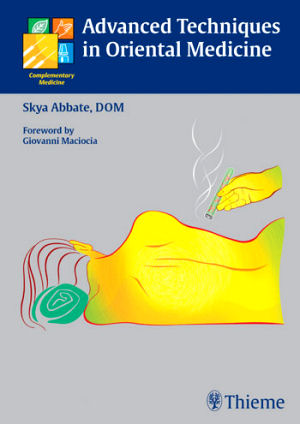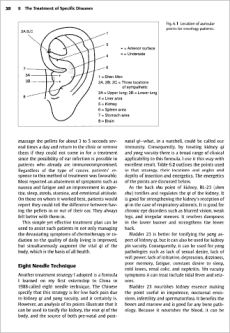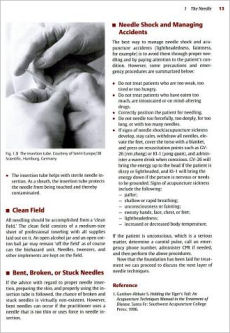Acupuncture and TCM Books
Advanced Techniques in Oriental Medicine
 Advanced Techniques in Oriental Medicine
Advanced Techniques in Oriental Medicine
Check New and Used Prices
Description
Taming the Tiger
"When you grasp the needle, do so with great care, firm strength and caution for the peril, as if holding a tiger?s tail: one wrong move and great harm could befall."--Huangdi Neijing
This uncommonly useful guidebook presents an overview of all aspects of needling, from the parameters of the needle itself to the importance of treating and anchoring the patient?s spirit. Skya Abbate?s clear language and detailed descriptions guide you step-by-step through thirteen categories of disease, ranging from anxiety, geriatric and chronic degenerative diseases to those illnesses thought to be untreatable.
Specialized chapters offer insight and guidance for practitioners seeking to enhance their treatment strategies with additional therapeutic techniques, including moxibustion, bleeding techniques, herbal liniments, infrared light, threading, and others. Rounding out the text is a practical appendix with a glossary of Chinese medical terminology, sample instructions for patients, as well as an index with more than 2,000 disorders.
Skillfully weaving the time-honored principles of Oriental medicine into the cutting-edge reality of the clinic, Advanced Techniques in Oriental Medicine offers a wealth of simple, yet effective, treatment strategies.
Table of Contents:
I General Approaches to Treatment
II The Treatment of Specific Diseases
III Other Modalities—Treatment Tools Complementary to Acupuncture
IV Specialized Use of Points
Page Views


Foreword
When comparing acupuncture to Chinese herbal medicine, it is often said that the latter is more difficult to learn and to practice. I tend to disagree.
Acupuncture is probably more difficult to learn and to practice because it involves so many variables.
To give an effective treatment, there are certain steps that are common to both acupuncture and herbal medicine, i.e.:
Q a correct diagnosis (whatever system or type of Oriental medicine is used)
Q a correct treatment principle
Q a correct choice of treatment.
With herbal medicine, if the diagnosis and treatment principle are both correct, the prescription practically picks itself because of the close identification of treatment principle with categories of prescriptions. For example, when we say that the treatment principle is to clear heat and cool blood we mean that we need to clear heat at the blood level: this automatically corresponds to the category of cooling blood prescriptions. Similarly, when we say that we need to resolve toxic heat it means that we need to choose a formula from the category of prescriptions that resolve toxic heat.
With acupuncture, the correspondence between treatment principle and choice of treatment is not as rigid or unequivocal. For example, there are only a few points that specifically cool blood (e.g., PC-3 qu ze). Therefore, cooling blood with acupuncture is achieved in a different way and without such a straightforward correspondence between treatment principle and categories of formulae as in Chinese herbal medicine.
The modality of working with acupuncture is profoundly different to that of Chinese herbal medicine. Chinese herbal medicine is based on the use of drugs of plant origin. These work in a different way to, and are intrinsically safer than drugs; however, they are drugs nevertheless. They contain active principles that affect the body´s physiology in a similar way to drugs. For example, to resolve edema with Chinese herbal medicine we may choose the formula Wu Ling San, which contains herbs that are diuretic and resolve edema by stimulating urination.
Acupuncture works in a completely different way because it essentially works only by regulating qi. In contrast to herbal medicine, how can acupuncture resolve edema? How can we stimulate urination with acupuncture? Acupuncture can resolve edema only by regulating the ascending/descending and entering/exiting of qi in the water passages of the three burners. When compared to herbal medicine, therefore, the acupuncture treatment is not rigidly determined by the treatment principle, and the choice of points is much more flexible.
Another important difference is that acupuncture is more subject to cosmic influences than herbal medicine. By that I mean that, being based on manipulation of a subtle energy such as qi, acupuncture is more subject to influences of the time of day, season, moon phase, the menstrual cycle in women, etc. For example, in an article in a Chinese medicine journal Dr. Chen Ming treated 43 patients with asthma by giving them acupuncture during specific solar terms and compared the results to those in 24 patients treated not according to solar terms.1
The solar terms are 24 periods of 2 weeks each in a year, beginning from the first day of the Chinese New Year (which would fall on a different date of the Western calendar each year). The solar terms during which the treatment was administered were:
Q Spring Equinox (4th solar term)
Q Summer Solstice (10th solar term)
Q Autumn Equinox (16th solar term)
Q Winter Solstice (22nd solar term).
The FEV (Forced Expiratory Volume) was measured in each patient in each group, and the patients treated according to the solar terms registered a better improvement than those who were not.
The fact that acupuncture is subject to cosmic cycles is probably the reason why a patient never reacts in the same way when we apply exactly the same treatment. For many years I have noticed over and over again that when a patient has a very positive reaction to a particular acupuncture treatment, the reaction is never the same when we repeat that treatment.
After deciding on a treatment principle, an acupuncture treatment is subject to many more variables than herbal medicine. In fact, after choosing a treatment principle, we still need to work out a suitable point combination that takes into account many factors, such as the actions of the points in relation to the pattern treated, the harmonious combination of points, the time of day, season, and even moon phase.
In fact, when choosing points for an acupuncture treatment there are two different considerations:
Q the selection of points according to their action
Q the combination of points according to channel dynamics.
Acupuncture works via the channels, not just via isolated points, so that each point should not only be considered for its individual action but also for its place within the channel system. Even if we master the action of each individual point, this is still not enough to give an effective acupuncture treatment, as each point must be seen within the dynamics of the channel system so as to attain a harmonious combination of points.
The balance of the point combination is essential to the success of an acupuncture treatment. Indeed, a balanced point combination is as important to the therapeutic result as the needling technique. The latter is, of course, very important to the success of an acupuncture treatment but the harmonious combination of points is often overlooked: they are both important because they reflect two different viewpoints. In a way, the stress placed on needling technique is based on a pointcentered view of acupuncture, while the stress placed on the combination of points is based on a channel-centered view of acupuncture. Both these viewpoints are important and both need to be taken into account.
When giving an acupuncture treatment, there are very many practical variables, such as a correct point location, correct needling direction and depth, correct obtaining of de qi, and correct needling manipulation. In addition, more variables are introduced when moxa is considered: Should we use moxa? On which point? Which type of moxibustion?
For all the above reasons, I think that acupuncture is very difficult to practice: it is indeed an art. There are comparatively few books that deal with the techniques of acupuncture in a detailed and practical way. Advanced Techniques in Oriental Medicine is such a book, which makes it so welcome to students and practitioners of acupuncture, whatever the style practiced.
Dr. Skya Abbate is uniquely placed to introduce the reader to the complexities of acupuncture as she has long experience both as a practitioner and a clinical teacher. She is therefore aware of the needs of students and practitioners. Dr. Abbate´s clinical and teaching experience is apparent in every page of the book.
The transmission of a medical tradition from one culture to another is always fraught with difficulties. When transmitting a medical system between two such different cultures as the ancient Chinese and modern Western cultures, the difficulties are even greater. I personally feel we should strike a balance between adhering firmly to the tradition and adapting this tradition to the needs of Western students and patients. Adhering rigidly and blindingly to tradition will not serve the needs of our patients, while adapting a medical system without fully understanding it first may create theories which have no basis in practice. Dr. Abbate´s book strikes such a balance as it presents the traditional techniques of acupuncture and creatively adapts them to the needs of Western patients. For example, there is an innovative and important chapter on the treatment of the spirit with acupuncture. She correlates spirit treatment with treatment of the blood level. Dr. Abbate´s book is an example of the kind of books needed to ensure a faithful and creative transmission of Chinese medicine to the West.
Advanced Techniques in Oriental Medicine
Check New and Used Prices